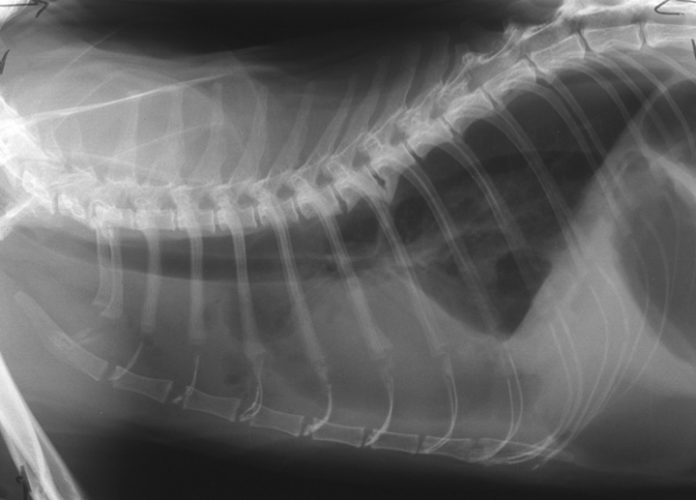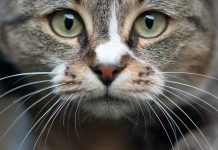Fluid around a cat’s lung, also known as pleural effusion, is an unusual build-up of fluid in a cat’s chest cavity.
This fluid sits around the lungs and prevents them from expanding as they should.
It’s a serious condition, but not just something that happens to cats. Dogs, rabbits, and other animals can also suffer from it. Even we humans are affected by pleural effusion.
Pleural Effusion Cats
Pleural effusion is not when fluid occurs in the lungs but when liquid is present outside of the lungs.
The build-up occurs in the space between the chest wall and the lungs. Naturally, this area is supposed to have a small amount of fluid that keeps the lungs from sticking to the chest wall.
However, the excessive build-up of fluid will cause severe complications as the lungs cannot properly expand.
It’s potentially a life-threatening situation for the cat, and in most cases, requires emergency treatment.
The condition can affect seemingly healthy cats, though it is more common in cats suffering from other illnesses.
Whatever the cause, pleural effusion in cats is very serious.
Types of Pleural Effusion
Several illnesses may cause fluid to build-up in a cat’s lungs.
Here are some things a vet might look for in making a diagnosis.
Hemothorax
Cats that have blood in their pleural space in the cat’s chest may be diagnosed with hemothorax.
The blood in the chest tends to hinder the lungs’ expansion, similar to chylothorax, and may cause breathing problems.
Chylothorax
Chylothorax is a rare condition that happens when the chyle’s lymphatic fluids accumulate in the chest cavity.
If this fluid reaches a particular level, the cat might not breathe well, as its lungs may not fully expand.
Causes of Pleural Effusion
Certain conditions may cause pleural effusion in cats.
Here are some of the most common causes of fluid accumulation in a cat’s lungs:
- Blockage of the central vein of the heart
- Higher than the normal hydrostatic pressure
- Being over hydrated
- Congestive heart disease
- Liver conditions
- Kidney disease
- Traumatic injury
- Heartworms
- Tumors in the chest
- Leaky blood vessels
- A blood clot in the lungs
- Fungal infection of the lungs
- Diaphragmic hernia
- Viral infection of the lungs
- Abnormal functioning of the lymphatic system
- Pancreatitis
- Cancer
- Twisting of the lung
- Low levels of the protein in the blood
- Bacterial infection of the lungs
Symptoms of Pleural Effusion
In case the cat has fluid on its chest, it’ll exhibit various symptoms.
The most common symptoms of pleural effusion in cats include the following:
- Problems in breathing when in an upright position
- Coughing
- High respiratory rate
- Intolerance to exercise
- Bluish tint around the mucous membranes
- Difficulty in breathing
- Lack of appetite
- Breathing with its mouth open
- Lethargy
Pleural Effusion Diagnosis

The vet will need some vital information from the cat owner to assist them in making a diagnosis.
They’ll start by taking a complete medical history from the cat owner.
The owner should include any information regarding the cat’s previous medical conditions, birth history, medications, and the date symptoms started.
Furthermore, the doctor will take the cat’s vital signs, such as weight, temperature, respiration, and heart rate.
They’ll also examine the cat, listen to its chest, and take blood and urine test.
If fluid is present, the vet might take an ultrasound or an X-ray of its chest.
Acquiring a fluid sample might also be a key in determining the cause of the pleural effusion in cats.
Treatments for Pleural Effusion
A cat abdominal breathing is life-threatening and an emergency for the cat.
It’s vital to see a vet the moment you notice any symptoms.
Many cats which develop pleural effusion have severe difficulty breathing and can deteriorate rapidly.
The best thing for treating this illness is to get rid of the fluid to restore free-breathing.
The vet will drain the fluid from the cat’s chest using a needle in a procedure called Thoracocentesis. This procedure is explained and demonstrated in the video above.
Certain conditions such as chylothorax can cause up to a quart of fluid to build-up in the chest.
If the fluid continues to build up, the vet might perform a surgical procedure installing a shunt.
This particular device should prevent ongoing problems with pleural effusion.









